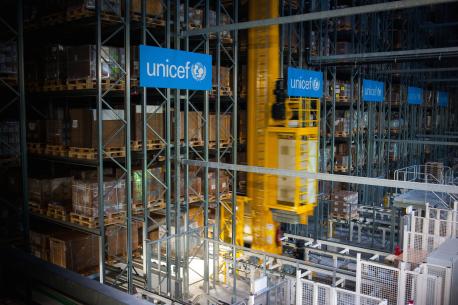
Peek Inside UNICEF's Massive Supply Warehouse in Copenhagen
A big part of what makes UNICEF so effective in emergencies is its ability to ship supplies from its Copenhagen warehouse to anywhere in the world within 48 to 72 hours. Your contribution helps UNICEF continue its lifesaving work for children.
Standing eight stories high, with a footprint the size of three football fields, it is the largest humanitarian warehouse in the world. More than 850 different supply items move through it, everything from oral rehydration salts to school supplies.
It is UNICEF's supply warehouse Copenhagen, Denmark — a big part of why UNICEF is able to meet the health, nutrition, education and other needs of vulnerable children all around the world.
In 2017, UNICEF procured $3.46 billion in supplies and services for children in 150 countries and areas. UNICEF's Supply Division, which manages procurement, leverages relationships with governments and other partners to get the job done efficiently and cost-effectively. It coordinates emergency shipments; accelerates immunization activities through a pre-financing program; and works with the Innovation team to develop fit-for-purpose and value-for-money supplies, such as warmer, more wind-resistant tents and tools to diagnose pneumonia in children.
As one of the world's largest buyers of lifesaving goods, UNICEF uses its marketplace muscle to stretch every dollar, getting more for less — and ultimately saving more young lives. By taking an increasingly local approach to sourcing and delivering Ready-to-Use Therapeutic Food, UNICEF has revolutionized the humanitarian response to nutrition crises — while improving the sustainability of humanitarian supply chains.

Every year a group of UNICEF delegates from near and far come to the state-of-the-art facility for an inside look — and some hands-on experience. © Sam Nuttall for UNICEF

UNICEF's Supply Division plays a key role in making sure children get continued access to vaccines. In late October, 4.7 million doses of measles, rubella & polio vaccines arrived in Libya to support an upcoming national immunization campaign that aims to reach 2.75 million children, including those in migrant communities, across the country. © UNICEF

In 2017, UNICEF procured more than $72 million worth of educational supplies for 12.5 million children in 150 countries and areas around the world as part of its mission to support continuous learning and development. © UNICEF

Supplies leave UNICEF's Copenhagen warehouse by cargo plane, bound for children and families who need them most. In 2017, UNICEF responded to 337 humanitarian crises in 102 countries — hurricanes, earthquakes, refugee crises and conflicts across the globe. © UNICEF/UN032282/Guhle
Please help UNICEF get emergency relief to the world's most vulnerable children.
Top photo: © Sam Nuttall for UNICEF
HOW TO HELP
There are many ways to make a difference
War, famine, poverty, natural disasters — threats to the world's children keep coming. But UNICEF won't stop working to keep children healthy and safe.
UNICEF works in over 190 countries and territories — more places than any other children's organization. UNICEF has the world's largest humanitarian warehouse and, when disaster strikes, can get supplies almost anywhere within 72 hours. Constantly innovating, always advocating for a better world for children, UNICEF works to ensure that every child can grow up healthy, educated, protected and respected.
Would you like to help give all children the opportunity to reach their full potential? There are many ways to get involved.



